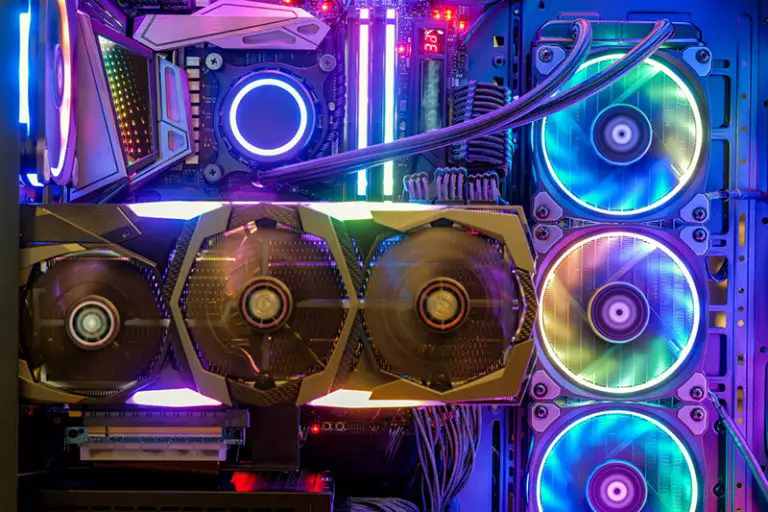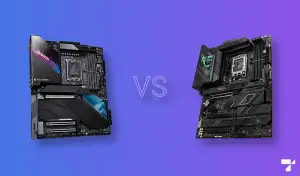If you are trying to decide between ARGB vs RGB, there are a few key factors you should consider. Firstly, ARGB provides addressable, therefore more dynamically configurable lighting customization while RGB provides only single color customization. RGB is static per color switch, while ARGB allows dynamic customization of each color switch.
In a nutshell, If you have a regular RGB strip and plug it into an RGB header, the whole strip is 1 color. If you have an ARGB strip and plug it into an ARGB header, you can customize each individual led color. This allows ARGB to produce more dynamic lighting such as cycling, flashing, sound syncing, etc.
While ARGB is the superior choice when it comes to customization of your lighting, color preference is a very subjective matter. Besides, RGB still has native application-based advantages that allow it to be quite relevant when compared to its more recent iteration ARGB.
What is ARGB?
ARGB stands for “Addressable Red Green Blue”. As the name suggests, this means that the RGB feature of that particular product is highly programmable, and can produce different colors from individual LEDs on the fly. If a component is rated ARGB-compatible, the entire color profile of that hardware is dynamic and can shift at a granular level depending on the user’s preferences. This is as opposed to simply showing single color switching, or displaying pre-set color patterns.
ARGB technology revolves around microcontrollers, which communicate via the signal line from a 3-pin 5V RGB header. Unlike regular RGB which only transmits color space information on all LEDs, every individual LED within the ARGB array can be addressed using the signal line. This then provides timing, patterns, color changes, and syncing (with other LEDs in the same array) through the entire connection.
Unfortunately, the same added steps that make ARGB dynamically configurable also make it the more expensive option. In addition, the marketing value of ARGB is also conceptually higher, and thus tech manufacturers have the incentive to offer the feature on higher product tiers, though it doesn’t really take too high to get to the most affordable ones.
What is RGB?
RGB stands for “Red Green Blue”. On its own (without context), it simply represents the standard model used to reproduce colors in any technological application today (most notably on displays/screens). When used exclusively in comparison to ARGB, it stands for the non-transitional, single-color switching lighting setup used for PC builds or related devices and peripherals.
In other words, when an RGB feature has not been specified to be addressable, it means that intricate color transitions and patterns are not available, and you are more or less limited to only changing the colors one at a time. Profiles can be made, but because no granular customization is available, patterns are limited to configuring red-green, and blue intensities (to reproduce the desired color), or simply turning the individual LEDs on or off.
Unlike ARGB, RGB technology is far more straightforward. Non-addressable RGB case fans and lighting strips, for example, can connect using a 4-pin 12V connector. The first pin supplies power, while the rest of the other pins provide red, green, and blue signals, with varying intensities representing values from 0-255. Depending on the value combination, a color can then be reproduced through the entire LED array.
As RGB does not use complex microcontrollers through its systems or controller hubs, transitions are far less elegant, if there is even any transition at all. Also, the 4-pin header must be connected in the proper orientation, or else the RGB pins will get jumbled up and create different colors from what you intended. There’s an arrow marker on the connector pointing to which side it should be connected, so it should be as easy as simply flipping and reconnecting in case the orientation is incorrect.
What’s the difference between ARGB and RGB?
To summarize, here are the fundamental differences when comparing ARGB vs RGB:
The main difference between ARGB and RGB
- ARGB allows you to customize and control each LED individually to whichever colors you prefer.
- RGB only allows for all LEDs to have the same color. Meaning once you change a color, you would change all the other LEDs to that said color.
Comparison table between ARGB vs RGB
| RGB | ARGB | |
|---|---|---|
| Connections | 4-pin 12V | 3-pin 5V |
| General Color Switching | Single Color | Single Color, Transition, Pattern |
| Individual LEDs | On/Off | On/Off, Color Change |
| Pattern Transition | Intensity, On/Off | Intensity, On/Off, Color Change |
| Hardware syncing | Yes | Yes |
| Software customization | Yes | Yes |
| Daisy-chaining | Practically no limit | Up to 4, but 3 Effective Max |
| Interpluggable? | Connects to 3-pin, but if power is severely limited, it might produce different colors than intended. | No. Plugging a 3-pin connector to 4-pin header is not recommended. |
| Error-proofing | Requires matching arrow marker to plug properly. | Signal pin is properly separated from ground and power pin. |
| Price/Cost | Generally cheaper | Considerably more expensive |
Is ARGB better than RGB?
Yes, ARGB is inherently better than RGB, but only from the perspective of pure option and customizability. Overall, ARGB and RGB are pretty much different options that cater to different personal requirements.
ARGB would be for those who want nice, smoother color transitions and individual LED shifting color profiles. This doesn’t even have to be an active choice. If you think you will eventually switch to dynamically changing color patterns at some point, then ARGB components will be more than worth the additional investment.
RGB would then be for those who don’t mind the static color changes and would pretty much only want their PC to show a uniform, single or dual-color theme. The setup is also pretty simple, with more opportunities for daisy-chaining. From a cost standpoint, regular RGB can also help save a lot of extra funds for more important PC parts, and away from what is otherwise a “mere” aesthetic addition.
ARGB vs RGB Headers: Are ARGB and RGB compatible?
The answer is both yes and no. If you are trying to plug an RGB connector (4-pin 12V) into an ARGB header (3-pin 5V), then it should still light up and provide color. Because you lose a single pin of connection, only two of the three color spaces are provided, thus the color of the connected hardware would differ from what you intended. Also, because you are connecting to a 5V connection, you can most likely only power one fan or strip with such a configuration.
But while plugging RGB connectors into ARGB headers is only inconvenient at most, directly plugging ARGB headers into RGB connectors is absolutely not recommended. Normally, this should not even be possible, since the third pin in the middle would stop the direct connection from going through. With an adapter-type splitter, the ARGB header can connect, but since you are passing through a significantly higher 12V connection through a 5V-rated component, you will inevitably fry the LEDs once the connection is established (the fan motors are not affected though).
The most ideal method to combine ARGB and RGB components is to use a controller hub that is rated to support both RGB and ARGB fans. These hubs have both 3-pin 5V and 4-pin 12V connections split equally, and are often powered by a supplemental external source, such as an extra SATA power connector from your PSU. Take note that while ARGB fans/strips could sync with the RGB fans/strips via single-color RGB modes, the RGB fans won’t be able to keep up with the same swirly color-shifting effects on multi-color ARGB modes.
Final Thoughts
RGB is an undeniable part of typical PC building nowadays, despite opinions on the contrary, and regardless of its inherent optional nature. To that end, the choice of whether RGB or ARGB is better for you is still pretty much a matter of investment and preference. Technically speaking, ARGB is better, since it can also provide what RGB does plus more. But other factors such as hardware compatibility, target theme/aesthetic, and overall cost could give standard RGB an edge in practical application. There’s also the question of whether transitional color effects and other dynamic changes to LED lighting are even useful for that particular user. If not, then RGB could be the better choice.



